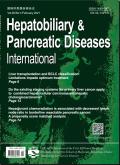Impact of prognostic nutritional index on survival in periampullary/pancreatic cancer patients undergoing pylorus-preserving pancreaticoduodenectomy: A propensity score-matched analysis
IF 4.4
3区 医学
Q2 GASTROENTEROLOGY & HEPATOLOGY
Hepatobiliary & Pancreatic Diseases International
Pub Date : 2025-06-23
DOI:10.1016/j.hbpd.2025.06.007
引用次数: 0
Abstract
Background
Although the prognostic nutritional index (PNI) may predict surgical outcomes in certain cancers, the impact of PNI on surgical prognosis in patients undergoing pylorus-preserving pancreaticoduodenectomy (PPPD) is unclear. This study aimed to investigate the impact of preoperative PNI on mortality rate and cancer recurrence rate in patients who underwent PPPD.
Methods
A total of 718 patients who were diagnosed with periampullary or pancreatic cancer and underwent PPPD between January 2012 and December 2016 were analyzed. Patients were categorized into two groups using the optimal cut-off value for PNI, determined by calculating the receiver operating characteristic (ROC) curve and the Youden index. We performed propensity score matching (PSM) analysis to compare the mortality rate and cancer recurrence rate between the two groups. In addition, Cox regression analyses were performed to examine the association of PNI with mortality rate and cancer recurrence rate.
Results
Using the 1-year mortality as an endpoint, the area under the ROC curve for PNI was 0.620 (optimal cut-off value: 41.7). We observed significant differences in 1-year (P = 0.001), 5-year (P = 0.002), and overall (P = 0.001) mortality; 1-year (P = 0.013), 5-year (P = 0.032), and overall (P = 0.017) cancer recurrence between groups after PSM. High PNI was significantly associated with reduced 1-year [adjusted hazard ratio (HR) = 0.44, 95% confidence interval (CI): 0.26-0.74, P = 0.020], 5-year (HR = 0.66, 95% CI: 0.52-0.84, P < 0.001), and overall (HR = 0.71, 95% CI: 0.57-0.88, P = 0.002) mortality; 1-year (HR = 0.70, 95% CI: 0.52-0.93, P = 0.016), 5-year (HR = 0.78, 95% CI: 0.62-0.97, P = 0.027) and overall (HR = 0.78, 95% CI: 0.63-0.97, P = 0.024) cancer recurrence.
Conclusions
Preoperative PNI may serve as an independent factor for short- and long-term surgical prognosis in cancer patients undergoing PPPD.
预诊营养指数对行保幽门胰十二指肠切除术的壶腹周围/胰腺癌患者生存的影响:倾向评分匹配分析
背景:虽然预后营养指数(PNI)可以预测某些癌症的手术结果,但PNI对保留幽门的胰十二指肠切除术(PPPD)患者手术预后的影响尚不清楚。本研究旨在探讨术前PNI对PPPD患者死亡率和癌症复发率的影响。方法:对2012年1月至2016年12月诊断为壶腹周围癌或胰腺癌并行PPPD的718例患者进行分析。通过计算受试者工作特征(ROC)曲线和约登指数,采用PNI的最佳临界值将患者分为两组。我们采用倾向评分匹配(PSM)分析比较两组患者的死亡率和癌症复发率。此外,还进行了Cox回归分析,以检验PNI与死亡率和癌症复发率的关系。结果:以1年死亡率为终点,PNI的ROC曲线下面积为0.620(最佳截断值为41.7)。我们观察到1年(P = 0.001)、5年(P = 0.002)和总死亡率(P = 0.001)有显著差异;PSM术后1年(P = 0.013)、5年(P = 0.032)、总复发(P = 0.017)组间比较。高PNI与降低1年[校正风险比(HR) = 0.44, 95%可信区间(CI): 0.26-0.74, P = 0.020]、5年(HR = 0.66, 95% CI: 0.52-0.84, P < 0.001)和总体(HR = 0.71, 95% CI: 0.57-0.88, P = 0.002)死亡率显著相关;1年(HR = 0.70, 95% CI: 0.52-0.93, P = 0.016)、5年(HR = 0.78, 95% CI: 0.62-0.97, P = 0.027)和总体(HR = 0.78, 95% CI: 0.63-0.97, P = 0.024)肿瘤复发率。结论:术前PNI可能是影响PPPD患者短期和长期手术预后的独立因素。
本文章由计算机程序翻译,如有差异,请以英文原文为准。
求助全文
约1分钟内获得全文
求助全文
来源期刊
CiteScore
5.40
自引率
6.10%
发文量
152
审稿时长
3.0 months
期刊介绍:
Hepatobiliary & Pancreatic Diseases International (HBPD INT) (ISSN 1499-3872 / CN 33-1391/R) a bimonthly journal published by First Affiliated Hospital, Zhejiang University School of Medicine, China. It publishes peer-reviewed original papers, reviews and editorials concerned with clinical practice and research in the fields of hepatobiliary and pancreatic diseases. Papers cover the medical, surgical, radiological, pathological, biochemical, physiological and historical aspects of the subject areas under the headings Liver, Biliary, Pancreas, Transplantation, Research, Special Reports, Editorials, Review Articles, Brief Communications, Clinical Summary, Clinical Images and Case Reports. It also deals with the basic sciences and experimental work. The journal is abstracted and indexed in SCI-E, IM/MEDLINE, EMBASE/EM, CA, Scopus, ScienceDirect, etc.

 求助内容:
求助内容: 应助结果提醒方式:
应助结果提醒方式:


